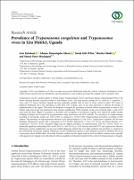| dc.contributor.author | Katabazi, Aziz | |
| dc.contributor.author | Almustapha Aliero, Adamu | |
| dc.contributor.author | Gift Witt, Sarah | |
| dc.contributor.author | Odoki, Martin | |
| dc.contributor.author | Musinguzi, Simon Peter | |
| dc.date.accessioned | 2024-03-20T10:54:26Z | |
| dc.date.available | 2024-03-20T10:54:26Z | |
| dc.date.issued | 2021-06-15 | |
| dc.identifier.other | doi.org/10.1155/2021/7284042 | |
| dc.identifier.uri | http://hdl.handle.net/20.500.12280/3070 | |
| dc.description.abstract | Trypanosomes are the causative agents of animal African trypanosomiasis (AAT) and human African trypanosomiasis (HAT), the former affecting domestic animals prevalent in Sub-Saharan Africa. The main species causing AAT in cattle are T. congolense, T. vivax, and T. b. brucei. Northern Uganda has been politically unstable with no form of vector control in place. The return of displaced inhabitants led to the restocking of cattle from AAT endemic areas. It was thus important to estimate the burden of trypanosomiasis in the region. This study was designed to compare the prevalence of animal African trypanosomes in cattle in Lira District using microscopy and polymerase chain reaction amplification (PCR) methods. In this cross-sectional study, a total of 254 cattle from the three villages of Acanakwo A, Barropok, and Acungkena in Lira District, Uganda, were selected by simple random sampling technique and screened for trypanosomiasis using microscopy and PCR methods. The prevalence of trypanosomiasis according to microscopic results was 5/254 (2.0%) as compared to 11/254 (4.3%) trypanosomiasis prevalence according to PCR analysis. The prevalence of trypanosomiasis infection in the animal studied is 11/254 (4.3%). Trypanosoma congolense was the most dominant trypanosome species with a proportion of 9/11 (81.8%), followed by T. vivax 1/11 (9.1%) and mixed infection of T. congolense/T. vivax1/11 (9.1%). Barropok village had the highest prevalence of trypanosomiasis with 6/11 (54.5%). There is a statistically significant relationship (; 95% CI: 1.634-22.331; ) between abnormal PCV and trypanosome infection. Polymerase reaction amplification was the most reliable diagnostic method due to its high sensitivity and specificity as compared to the conventional microscopic method. Polymerase reaction amplification appears to have adequate accuracy to substitute the use of a microscope where facilities allow. This study, therefore, underscores the urgent need for local surveillance schemes more especially at the grassroots in Uganda to provide data for reference guideline development needed for the control of trypanosomiasis in Uganda. | en_US |
| dc.language.iso | en | en_US |
| dc.publisher | Hindawi | en_US |
| dc.relation.ispartofseries | BioMed Research International;Volume 2021, Article ID 7284042, 7 pages | |
| dc.subject | Trypanosomes | en_US |
| dc.subject | Animal African trypanosomiasis (AAT) | en_US |
| dc.subject | Human African trypanosomiasis (HAT) | en_US |
| dc.subject | Sub-Saharan Africa | en_US |
| dc.title | Prevalence of Trypanosoma congolense and Trypanosoma vivax in Lira District, Uganda | en_US |
| dc.type | Article | en_US |


